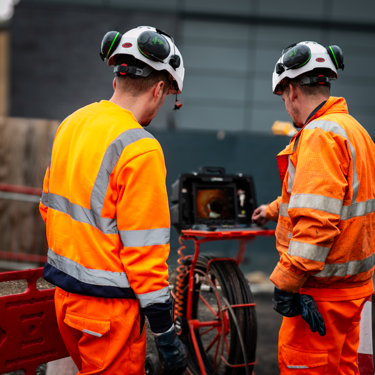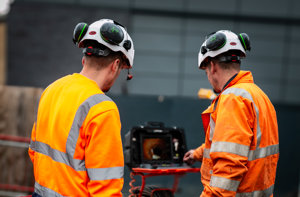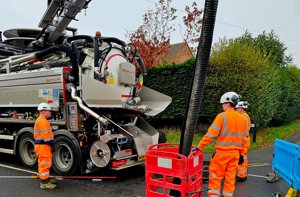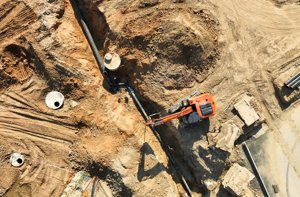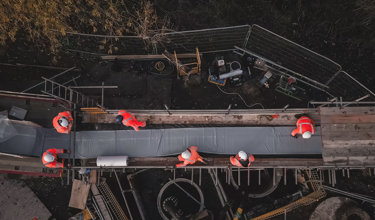
Trenchless remediation
We deliver trenchless solutions on collapsed sewers and pipelines, leaks, displaced and offset joints, failed pitch fibre pipes, upsizing of pipes and works that are difficult to access and excavate.
Avoiding digging up roads, gardens and driveways is a less disruptive, more environmentally friendly, faster and more economical solution.
Following a CCTV survey to evaluate the condition of the pipe, our experienced engineers assess the site and local environment and calculate the most appropriate solution.
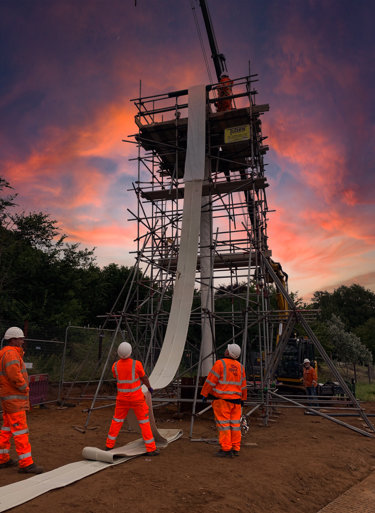
Benefits
Less disruption, less waste, faster, and more cost-effective than traditional excavation methods.
Invested heavily in the latest trenchless technology to bring you the most innovative solutions on the market.
Members of UK Society for Trenchless Technology (UKSTT) to share best practice and knowledge of trenchless solutions.
Pipe installation or replacement
Pipe bursting
We operate a wide range of specialist pipe bursting rigs including static and dynamic. The installation process consists of replacing a defective pipe or to upsize individual assets. Our team are trained in hydraulic pipe bursting techniques and plastic pipe welding for butt fusion and electro fusion joints. Pipe bursting is the only trenchless method that allows for the installation of a larger diameter pipe than the existing host pipe, a process known as "upsizing." This technique increases capacity and can help mitigate flooding and pollution.

Horizontal directional drilling
Horizontal directional drilling (HDD) is a trenchless construction method used to install pipes underground without disturbing the ground surface. The drill is launched from one end of the designed bore path and retrieved at the other end, and except for the launch and retrieving spaces above ground, the entire process takes place underground, out of sight.
Impact moling
Impact moling is a method used for the installation of small diameter pipes or cables using a pneumatic hammering tool. It is the simplest form of trenchless installation of pipelines for water, sewer, and gas under roads, embankments and other small crossings. Impact moling is easy to operate, is low cost, and requires little to no excavation for the connection and termination pits.
Cured-in-place pipe (CIPP) lining
Cured-in-place pipe (CIPP) is a resin-impregnated liner installed by winching into place or using air or water to expand the liner, forcing it against the walls of the host pipe. Allowing the liner to travel along the full length of the asset - this is known as inversion. Curing methods include ambient curing, hot water, steam, UV or LED light. Therefore curing the liner into a new structural pipe formed within the existing asset, reducing friction to improve flow characteristics and creating a sealed pipeline that prevents infiltration and exfiltration.
Robotic cutting is used for reopening lateral connections and putting the sewer back into operation.
Pitch fibre re-rounding
Pitch fibre pipes are made from layers of wood pulp and pitch pressed together with bitumen. Pipes are susceptible to deformation and blistering which is a major cause of household blockages. We use a specialist re-rounding tool mechanically drawn through the pipe and once the pipe is round, we then install a CIPP liner to prevent any further deformation, increase flow rate and supply structural strength.
UV lining process is the fastest and most cost-effective way to repair a collapse or damaged pipe. Unlike most CIPP liners, the UV system is cured by ultra-violet light rather than hot water or steam. Not only does this allow much quicker installation and curing, but it also avoids any risk of pollution from the disposal of contaminated water.
The process involves inserting a Glass Reinforce Polyester (GRP) liner impregnated with a special resin into the sewer or drain. As the liner is inserted into the pipe, it is pulled into place and then inflated with air. A UV light train with built in CCTV is pulled through to check the positioning and identify any obstructions. The UV lights are then ignited, causing the resin cure and effectively creating a new pipe within the existing pipe and restoring the integrity of the drain or sewer.
LED lining works in the same way to UV lining, but uses a blue LED bulb rather than UV light to cure the liner. The smaller bulb means it can be used in smaller pipes and on up to 90o bends.
The resin-impregnated liner is installed using a compressor and an inversion drum and is cured by the external temperature. This method is quick and is ideal for managing existing flows. It can be done from one access point.
A hot cure liner can be used on any diameter of pipe and go around bends. A resin-impregnated liner is inserted into the pipe and inverted through to the next manhole. The liner is filled with water, which is heated to around 85 degrees and circulated for 4 hours until the liner is cured. Once cool, the liner is cut to release the water so that the liner can be trimmed and any lateral connections cut.
Steam cure lining for pipework is a technique used in Cured-in-Place Pipe (CIPP) relining where steam is used to cure the resin-impregnated liner within a damaged pipe. This process involves inserting a flexible liner into the damaged pipe, then inflating it with air or water to expand it against the pipe walls. Once in place, steam is introduced to heat the liner and cure the resin, creating a durable, new pipe within the old one.
Pressure main lining
Our pressure pipe lining is designed for use in highly pressurised pipelines carrying firewater or gas, such as rising mains. Unlike other liners, our solution is self-supporting and doesn’t require curing.
Primus Line is a non-structural lining solution for rehabilitation of medium and high-pressure pipelines for water, gas, and oil. It is installed by winching into place.
SAERTEX-LINER® is a UV-cured liner suitable for sewerage, gas, and water pipelines.
Close-fit PE pipe
Our close-fit PE pipe is designed for the renewal of existing pressurised and gravity-fed drinking water, gas, and wastewater pipelines made of steel, cast iron, or concrete.

Patch repairs
Patch repairs are used when there is localised damage such as cracks or root ingress. The patch consists of a length of glass fibre matting, which is coated in resin.
To install the patch, the matting is rolled around a “packer”, which is then pulled through the pipe run until it is situated at the correct place. The packer is then inflated, forcing the patch to adhere to the pipe wall. Once the patch has cured, the packer is deflated and removed, leaving the patch in situ.
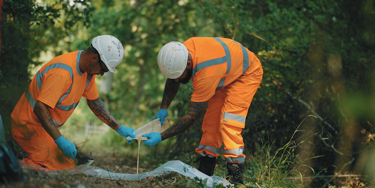
Robotic cutting
Precise and controlled cutting of defective pipework, hard deposits, root ingress, concrete / grout, and encrustation is used to remediate underground sewer and drainage systems.
The specialist robotic cutter is remotely operated and equipped with cutting tools, such as high-speed rotating blades and carbide cutting heads, to remove obstructions, roots, and other debris, as well as to trim, shape, or repair damaged sections of pipes.
It allows for accurate and targeted pipe maintenance without the need for extensive excavation, reducing costs and minimising disruption to the surrounding environment.
Chamber/manhole remediation
We use an automated ultra high-pressure jetting system and automated grouting system along with manual grouting pumps to clean chambers and manholes and bring the surfaces back to a sound stable substrate.
This is followed by spray lining of chamber walls to the desired thickness to protect from future degradation, hydrogen sulphide and other chemical attack.
Injection grouts and resins are used which react rapidly with water and expand to seal off infiltration and prevent exfiltration.
You might also be interested in...
Here to keep your pipework structurally sound and serviceable
Our experts are available now to help you understand and improve the condition of your assets.
Contact us